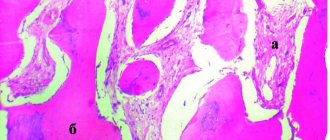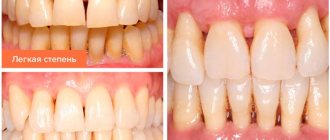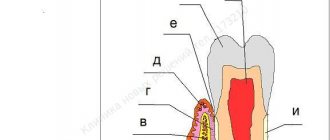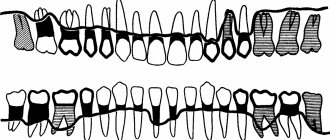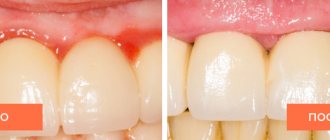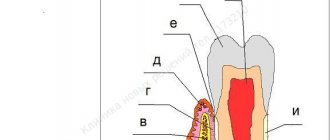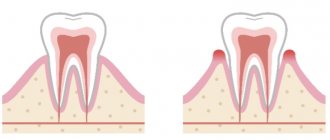All tissues of the oral cavity, both teeth and gums, are interconnected and naturally have a complex structure. Gums, just like teeth, require careful and thorough care. Periodontology is a separate science in dentistry that deals with the study of gum disease. Inflammation from the teeth can spread to periodontal tissue, and vice versa. Therefore, it is so important to maintain careful hygiene of the entire oral cavity and promptly treat any dental diseases.
Gum structure
The periodontium consists of a complex of tissues that form the entire periodontal space.
- Periodontium is a complex of fibers that hold the dental unit in the socket. The periodontium is located between the cementum and the alveolar wall. Nerve fibers, lymphatic vessels, veins and arteries are also located here, which together are responsible for the proper metabolism of the tooth.
- The gums are the outer part of the entire complex. The gums are the first to bear the brunt of harmful microorganisms that enter the oral cavity.
- The alveolar process is a bone plate that has a spongy structure and serves as a bed for the dental unit.
- Cement is the outer covering and protection of the tooth root.
- Enamel covers the crown of the tooth and is the hardest element of the entire complex.
- The pulp is the main source of metabolism in the tooth. Consists of blood vessels and nerve endings.
- Dentin is a substance located around the pulp and consisting mainly of mineral components.
TREATMENT OF PERIODONTAL DISEASES
Treatment
Periodontal diseases should always be comprehensive, that is, general and local treatment should be combined.
By general treatment we mean taking drugs that have an immunostimulating, body-strengthening effect. Local treatment
involves influencing the source of the disease itself, namely, the periodontal pocket or inflamed area
of the gum
. Our clinic uses the following types of local treatment of periodontal diseases:
- Therapeutic (conservative) - used for mild gingivitis and periodontitis - application to the gums or injection of medicinal substances with antiseptic, anti-inflammatory, sclerosing effects into the periodontal pocket.
- Surgical – used for moderate and severe forms – curettage (closed and open) of periodontal pockets followed by therapeutic treatment.
- Laser treatment is essentially a type of surgical treatment, but it has its advantages: painless procedure, high-quality antiseptic treatment of the pocket, faster healing without the formation of edema.
Each type of treatment is indicated in each specific case, and the treatment regimen is developed strictly individually, taking into account the general somatic condition of the patient.
After quality treatment, prevention plays an important role, namely: careful oral hygiene, the use of not only traditional hygiene products, but also those specially designed for the prevention of periodontal diseases, and, finally, regular medical examinations with your dentist.
Periodontal functions
In a healthy state, the periodontium performs a number of functions assigned to it:
- Support. The main function is due to which the tooth is held between bone plates.
- Shock-absorbing function. Correctly distributes pressure over the entire dentition.
- Trophic. A function responsible for nutrition and ensuring metabolism of the tissue complex.
- A protective function that helps create a barrier against the effects of bacteria.
- Reflex – affects the correct distribution of the chewing load.
- The plastic function is responsible for the elasticity of periodontal tissues.
Classification of periodontal diseases.
Gingivitis
Gingivitis is an inflammatory superficial disease of the gum tissue.
With gingivitis, there is no disruption of the periodontal junction and bone. Based on the form of manifestation of periodontal disease, the following are distinguished:
- catarrhal gingivitis,
- hypertrophic gingivitis,
- ulcerative gingivitis.
According to the type of course, gingivitis is divided into acute, chronic, aggravated and remission. According to the distribution, gingivitis can be localized and generalized. Without active treatment, gingivitis progresses to periodontitis.
Periodontitis.
Periodontitis is a deep inflammatory disease of the periodontium with destruction of the periodontal junction and bone tissue of the alveoli.
There are acute, chronic course of periodontitis, exacerbation of the disease and remission. Periodontitis can be mild, moderate or severe.
According to the prevalence, this gum disease is divided into generalized and localized periodontitis.
Photo 1. X-ray picture of severe periodontitis. The roots of the teeth are exposed by two-thirds.
2. 1.
Additionally, there is a condition known as
an aggressive form of periodontitis.
This diagnosis can be made by a doctor based on the presence of a set of signs of gum disease. In this case, periodontal destruction is generalized and rapid.
Such periodontitis is typical for ages from adolescence to 35 years. Often the aggressive form of periodontitis is accompanied by gum growth and granulation. During the period of remission, inflammatory manifestations may subside and even disappear.
Periodontal disease
Periodontal disease is a chronic degenerative periodontal disease.
In European and American classification as a separate gum disease
doesn't stand out. Periodontal disease is characterized by a long-term, benign course and almost does not lead to loosening and loss of teeth.
Periodontal diseases - as symptoms of other diseases
There are idiopathic periodontal diseases with progressive destruction of periodontal tissue (periodontal syndrome).
Such conditions can occur when exposed to physical factors (radiation), poisoning, immunodeficiency, diabetes mellitus, eosinophilic granuloma, Papillon-Lefevre syndrome, neutropenia, etc.
Periodontomas. Epulis (epulid) and gingival fibromatosis
Periodontomas are tumors and tumor-like conditions of the gums. The most common of them are epulis (epulid) and gingival fibromatosis.
Gingival fibromatosis is characterized by the proliferation of periodontal tissues, which causes tumor-like damage to the gum tissue. Gingival fibromatosis is most common in adults, but is sometimes diagnosed in children.
The diagnosis of gingival fibromatosis is made by a specialist based on the patient’s complaints, examination data, radiography, and histological examination.
The main reason for the growth of gum tissue, as a rule, is a violation of metabolic processes; drug-induced fibromatosis of the gums is also identified. Treatment of the disease is surgical and consists of excision of the overgrown gum to the periosteum.
Photo 2. Gingival fibromatosis
Periodontal diseases
Reasons why gum disease occurs:
- soft and hard plaque on teeth;
- anomalies in the location of dental units;
- poor-quality prosthetics or treatment;
- genetic predisposition;
- reduced immunity;
- diseases of internal organs;
- hormonal imbalances in the body;
- constant stress;
- various bad habits;
- Irregular oral care.
In contrast to the large number of causes influencing the development of periodontal diseases, there are not so many diseases themselves:
- Gingivitis is the initial stage of gum inflammation.
- Periodontitis is an inflammatory process in the gums, gradually spreading to the alveolar processes of the jaw.
- Periodontal disease is a fairly severe form of the disease, characterized by exposure of the roots of the teeth.
- Periodontoma is the formation of tumors in soft tissues.
Structure and functions of periodontium
The periodontium is a complex morphofunctional complex of tissues that surrounds and holds the tooth in the bone. All elements that make up the periodontium (gingiva, periodontium, alveolar bone tissue and cementum) are closely related in development and structure, which ensures the performance of various and very complex functions - barrier, trophic, plastic, support-retaining, etc. At the same time, each individual the element has its own characteristics.
The gum, over a considerable length, tightly fuses with the periosteum of the alveolar process of the jaw. The multilayered squamous epithelium covering the alveolar part of the gum (on the side of the oral cavity) contains cells that, under normal conditions, become keratinized, which provides a protective function in response to chemical, mechanical and other irritants.
The structure of the main (intercellular) substance of the gums is also aimed at performing a barrier function, increased regeneration, and maintaining homeostasis. The protection of the gums from various irritating factors, including microbial ones, is provided by the hyaluronic acid - hyaluronidase system. With an increase in the activity of hyaluronidase of microbial origin, the permeability of the basic substance of connective tissue is sharply disrupted and conditions are created for the development of inflammatory changes.
Fibrous structures with a predominance of collagen fibers ensure normal gum density. Cellular elements, and above all fibroblasts, carry out collagen formation and collagen renewal. A variety of cells (micro- and macrophages, plasma cells, mast cells, etc.) provide a protective function (phagocytosis, pinocytosis, antibody formation).
In elucidating the etiology and pathogenesis, as well as in determining ways to prevent inflammatory periodontal diseases, the concept of epithelial attachment to the gingival sulcus becomes important. It is these sections of the periodontium that are a barrier to various irritants, primarily of microbial origin, and it is in these areas that the pathological process of inflammatory genesis begins.
The gingival sulcus refers to the gap-like space between the surface of the tooth and the adjacent gum. The gingival groove and epithelial attachment perform a protective function for the periodontium.
The epithelium of this section never keratinizes and consists of several layers of cells located parallel to the surface of the tooth and quickly renewing themselves (every 4-8 days). The epithelial attachment is not adjacent to the tooth surface, but fuses tightly with it, and as long as this barrier is intact, the underlying periodontal tissues are not infected.
Gingival fluid plays an important role in the protective function of the periodontium. It contains enzymes involved in carbohydrate, protein and other types of metabolism. Normally, the activity of some enzymes in gingival fluid is 8-10 times higher than those in blood serum. The proteins contained in the gingival fluid, including immunoglobulins, have the same properties as plasma proteins.
Leukocytes are constantly found in the gingival fluid, the number of which increases significantly during inflammation, which is the body’s protective reaction in response to damage to the oral mucosa, in particular, periodontal disease.
Treatment
Treatment of major periodontal diseases is as follows:
- removing all plaque and then polishing the teeth;
- treatment of existing carious formations;
- carrying out high-quality prosthetics, if necessary;
- splinting of the dentition (also carried out if necessary);
- treatment of existing common diseases;
- taking vitamins or medications;
- Regular cleaning of the oral cavity not only at home, but also in the dental office.
In the most difficult situations, in addition to the listed treatment, surgical intervention may be necessary.
CLASSIFICATION
Periodontal diseases include:
- Gingivitis, or inflammation of the gums. The main symptom that may indicate that you have gingivitis is bleeding gums when brushing your teeth. Gingivitis can be catarrhal - that is, expressed only in redness of the gums, hypertrophic - gum growth is observed, ulcerative - ulceration occurs.
Periodontitis
- inflammatory disease of periodontal tissue. In addition to bleeding, periodontitis causes tooth mobility and pain. But the most important symptom of periodontitis is the presence of a so-called periodontal pocket between the root of the tooth and the gum, from which purulent discharge often comes. The process can be localized - within a group of teeth, or generalized - spread to the entire dentition.
Periodontal disease
– non-inflammatory periodontal disease. A characteristic feature is that with this form there are no inflammatory phenomena and periodontal pockets.
The teeth are well fixed, but their necks are exposed. If you do not engage in active treatment
, you can lose the affected teeth very quickly.
